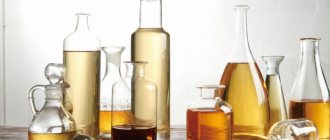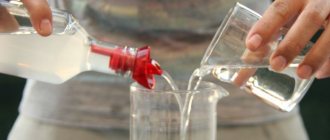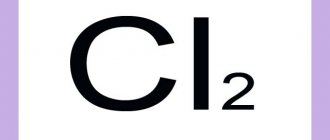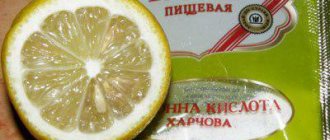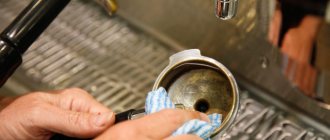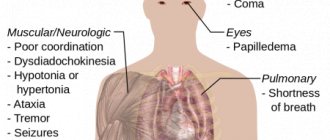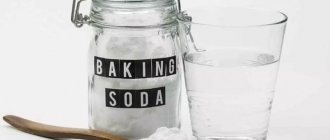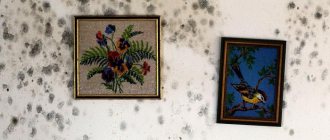Bite is an extremely important additive in cooking, without which we cannot make winter preparations, delicious marinades, all kinds of snacks, etc. But the most important thing here is to know when to stop so that the dish does not turn into inedible and harmful sourness, and for this it is important to be able to dilute the vinegar to the required concentration.
In recipes in the list of ingredients you can find: “vinegar essence”, “table vinegar”, vinegar 70%, 9%, 6% or 3%. Although all this is called the general word “vinegar,” these solutions are very different and should not be confused with each other. Let's briefly look at which of them is which.
There is an active substance called “acetic acid”; solutions of water and this acid can be found in stores.
- Acetic essence is a solution with an acid concentration of 70-80 percent.
Grocery stores usually stock 70 percent vinegar. Such a “strong” solution should be diluted, since in its pure form it poses a danger to the body; it is easy to overdo it with essence, thereby ruining the dish.
- There is also the so-called “table vinegar”. These are solutions with a concentration of acetic acid of 3-15 percent. More often in stores you can see 9% vinegar. Using this vinegar is very convenient; you can immediately scoop it into a spoon and add it wherever you need it.
It turns out that you need to keep 10 bottles of different vinegars at home? Some people do this, but in general, you can store one essence and simply dilute it at the right time. Below is all the detailed information on this topic.
What is vinegar essence
First, let's clarify what vinegar essence is. This is a 70% aqueous solution of acetic acid. This solution contains 7 parts acid and 3 parts water. Sometimes you can find 80% and 30% essence on sale. Accordingly, in the first the ratio of acid and water will be 8:2, and in the second – 3:7. Such concentrated solutions are dangerous; if taken orally, they cause burns to the mucous membranes of the digestive tract. In industrial production it is called the food additive E260, and housewives use it in the kitchen and for household purposes in the form of diluted table vinegar. Table vinegar is also sold in stores, its concentration ranges from 3% to 9%. In addition, on the shelves you can find vinegar made from natural raw materials: apple, wine, malt, balsamic, sherry and even coconut. This product is used for preparing culinary dishes.
And yet, the essence is most in demand for everyday needs. After all, from one teaspoon you can prepare a whole glass of table vinegar. Before we learn how to dilute vinegar essence 70%, let's focus on the quality of the original product.
How to make 6% from 9% vinegar - tips
Vinegar itself is an acidic solution, so when working with it you should follow safety rules, especially if you use vinegar essence. After all, the concentration of the substance is about 70%. After all, you can first prepare 9% vinegar from the essence, and then make 6% vinegar from 9% vinegar.
How to dilute vinegar correctly
To avoid any problems and injuries, take the process seriously:
- Dilute the essence only with rubber gloves. So that the acid does not apply to the epidermis.
- Pour water into the essence, not the other way around.
- There is no need to smell the contents of the essence bottle. It has a low evaporation temperature, which increases the risk of burning the nasal mucosa.
- Not any water is suitable for diluting vinegar and vinegar essence. It is advisable to use distilled or purified water; cold boiled water is also allowed.
- Do not store diluted vinegar and vinegar essence in public places; label the bottles so that household members do not think that it contains water.
- A weak solution of 6% vinegar should not be exposed to the sun, as it may lose its properties.
Also read articles on our portal on similar topics here:
- How to make apple cider vinegar?
- How to make 9% vinegar from essence?
- How to bring down the temperature of an adult patient with vinegar and vodka?
- How to reduce a child's temperature with vinegar?
- How to properly extinguish baking soda with vinegar when preparing baked goods?
- Apple cider vinegar for weight loss.
How to buy good quality vinegar
High-quality essence is sold only in glass bottles. There should be three convex rings on the neck of the bottle to warn visually impaired people that the product is dangerous for ingestion. There are also four horizontal stripes on the bottle; between the bottom two there is a manufacturer’s stamp on the inner surface of the glass. The label indicates the concentration of vinegar - 70%. When shaken, the contents foam, then within two to three seconds they become the same. If the bottle is counterfeit, the foam will last longer than ten seconds. Do not buy counterfeits, they are harmful to your health and, at best, will ruin your prepared dishes and preserves.
Usually the label gives very brief instructions on how to dilute vinegar essence. Manufacturers write that you need to dilute the original product with water one to twenty. To obtain a solution of different concentrations, the amount of starting ingredients will be different. You can use a mathematical formula.
What kind of vinegar can be found on store shelves?
Numerous supermarkets offer the buyer several types of acetic acid.
| Origin | Raw material composition of the product | Fortress | Application area |
| Natural | Apple, wine, malt, rice | 6%-9% | Cooking of the peoples of the world; home cosmetology |
| Natural, infused with spice combinations | Garlic, balsamic, tarragon | 6%- 9% | Adding to sauces and salads to give a piquant unique taste |
| Synthetic | Wood and natural gas products | 6% — 10% | Seasoning ingredients: mustard, ketchup; adding to baked goods |
| Vinegar essence | Chemical industry products | 70-90% | Not used in this concentration, intended for dilution in the required proportions |
Mathematical calculation
For those who are good with mathematics, the easiest way to dilute the essence to the required concentration is using the formula:
- The amount of essence required to obtain table vinegar = the desired concentration of the solution * the volume of the finished solution we need / the concentration of the essence.
For example: how to dilute vinegar essence to obtain 200 ml of 9% table vinegar.
9% * 200 ml / 70% = 25.7 ml of essence, add water to 200 ml.
In another option, you can go from the opposite.
- Amount of water required for dilution = amount of essence * concentration of essence / desired concentration of solution.
For example: it is necessary to dilute 15 ml of 70% vinegar essence to 6% table vinegar.
To do this, you need the following amount of water: 15 ml * 70% / 6% = 175 ml of water.
To measure volume, you can use a measuring cup or rely on the following numbers:
1 teaspoon = 5 ml, 1 dessert spoon = 10 ml, 1 tablespoon = 15-20 ml (depending on its depth). Classic faceted glass: full = 250 ml, rim = 200 ml, vodka shot glass = 50 ml.
For those who don’t want to bother with calculations, we suggest using standard coefficients.
Table vinegar (9%) can be replaced with apple cider vinegar.
But you need to understand that apple cider vinegar is sold at 5%, that is, to use it instead of 9% vinegar, you will need 2 times more apple cider vinegar. Instead of 1 tablespoon of 9% vinegar, take 2 tablespoons of apple cider vinegar.
Apple cider vinegar, grape (wine), rice vinegar, balsamic vinegar and others are most often used NOT for canning, but for dishes (borscht, salads, dressings) or marinating meat and fish. Since they still have their own specific taste, introduce them into your family’s diet carefully, because as you know, we are often conservative in our tastes, especially children.
You need to be even more careful if someone in the family has gastritis, ulcers or colitis, as well as
How to make nine percent vinegar
Table vinegar of this concentration is used for canning food. How to dilute vinegar essence to obtain a solution with a concentration of 9%? It is necessary to dilute the essence with 70% water in the ratio: 1 part concentrate and 7 parts water. That is, for 0.5 liters of water you need to add 75 ml of essence (one and a half shot glasses).
A solution of table vinegar is recommended to be used as a rubdown for diseases accompanied by an increase in body temperature. How to dilute vinegar essence at temperature? Pour one liter of water into an enamel bowl and add 2 tbsp. l. 9% table or apple cider vinegar.
Areas of application of acetic acid of different concentrations
Acid in its pure form (glacial), essence and all concentrations above 30% are more often used in industry, medical, and chemical laboratories. It is also used:
- in book printing;
- for obtaining fragrant, medicinal compositions;
- as a solvent;
- for coloring.
Medicinal products containing acetic acid are used to combat:
- dental plaque;
- pediculosis;
- thrush;
- warts;
- fungus;
- hearing problems;
- deviations in blood glucose levels;
- surges in blood pressure.
If acetic acid is diluted with water to lower concentrations, the solution is used in cooking, folk medicine and everyday life.
Table 1. Areas of application of diluted vinegar essence
| Concentration, % | Scope of application |
| 3 | Dressing for vegetable salads. For rinsing hair. For wiping the skin. For weight loss. For compresses against high fever in a child. For the treatment of joints, heel spurs. |
| 5 | Seasoning for dumplings, salads made from fresh cucumbers, cabbage, and beets. |
| 6 | For baking dough, for pancakes. In marinades for chicken. For marinating pork and beef skewers. For compresses and wiping off fever in adults. |
| 7 | For pickling garlic, onions, mushrooms. |
| 9 | Food additive for canning. Dressing for borscht. Seasoning for soup. For pickling cucumbers. |
| 10 | To eliminate unpleasant odors in the refrigerator. To remove scale. For cleaning and disinfecting cutlery and sanitary ware. |
| 25, 30 | To break down fat. To remove rust. In the fight against pests of garden, garden, and home plants. |
Important! Using even diluted vinegar for cosmetic and medical purposes without the supervision or consultation of a pediatrician, therapist, or cosmetologist can be dangerous.
How to make three percent vinegar
Table vinegar with a concentration of 3% is used to season ready-made dishes: salads, dumplings, pickled mushrooms, onions, sauces, etc.
How to properly dilute vinegar essence and get a three percent solution: take 22 parts of water for one part of essence. To prepare 0.5 liters of table vinegar you need 20 ml of vinegar essence 70%.
Dilute the essence in a glass or enamel container. First, the required amount of clean drinking water is measured into it. The water should be cool. Then add the calculated amount of vinegar essence. Avoid contact of the concentrate with the skin and especially with the mucous membranes of the eyes and mouth. But if such a nuisance does occur, rinse the affected area under cool running water. Store vinegar essence in a dark place out of reach of children. Remember, this is an acid and can be harmful to your health if not handled correctly.
How to make 6% from 9% vinegar: measuring spoons, glasses and other utensils
It is not often necessary to dilute vinegar or vinegar essence to prepare a variety of dishes. And if there are no kitchen scales, then you will need dishes, spoons, glasses, etc., where you will know approximately how much liquid is included. Next we will learn how to make 6% vinegar from 9% vinegar. It is clear and understandable that a decrease in the strength, or rather the concentration of the product, will occur due to its dilution with water.
How much in tbsp. grams of different products
Above is a table showing how much vinegar is included in a regular tablespoon. To obtain a solution concentration of 6%, take two spoons of a 9% solution and one spoon of water, the product is ready. If you need a large amount of vinegar, then use the same proportions: 1 to 2, but in glasses or shot glasses. By the way, a regular faceted glass contains 100 milliliters of vinegar.
Measuring portions of products in a particular dish
IMPORTANT: A teaspoon will hold 5 milliliters of vinegar, and a tablespoon will hold 15 milliliters, a regular glass will hold 200 milliliters, and a shot glass will hold 100 milliliters.
Measuring table
You never know what strength of vinegar you will need tomorrow and you never know for what purposes it may be needed (in case you didn’t know, vinegar is used not only for cooking).
A certain solution can also serve for disinfection purposes (at least this was the case in ancient times), but modern people can take note of this (after all, you never know what conditions you will find yourself in). Perhaps vinegar will be the only remedy that can help solve any problems or problems.
To obtain the desired consistency, you can easily measure the proportions in the number of spoons. Let's figure out below how much water you need to add to 1 tablespoon of 70 percent vinegar:
- 3% solution - 22.5 tablespoons of water;
- 4% solution - 17 tablespoons of water;
- 5% solution - 13 tablespoons of water;
- 6% solution - 11 tablespoons of water;
- 7% solution - 9 tablespoons of water;
- 8% solution - 8 tablespoons of water;
- 9% solution - 7 tablespoons of water;
- 10% solution - 6 tablespoons of water;
- 30% solution - 1.5 tablespoons of water.
The raw material for the production of vinegar is ethyl alcohol. Vinegar is used in culinary recipes for many dishes - and that's not all. It is impossible to do without it when preparing various kinds of seasonings and marinades. The popularity of vinegar is so high that it is even added to hot dishes (at the same time improving their taste). It can be produced both in artificial and natural conditions. It is present in ketchup, mustard and mayonnaise - that is, in our everyday food.
Home savings - which vinegar to choose?
When choosing a salad dressing, the issue is resolved automatically - of course, only natural! But when using the product for domestic purposes, there is no point in using expensive aromatic acid to clean the oven or hood of grease. For this, there is an economical vinegar essence, which is diluted with water in the required concentration. To rinse hair in home cosmetology, it is quite possible to use 70% vinegar, diluted to 6%.
Any housewife always has expensive natural vinegar in her house for cooking, and budget vinegar essence for other needs.
In household chores, 6% vinegar is often required, which can always be made
from an inexpensive concentrate available in the house.
Types of vinegar
- Red wine vinegar, which is obtained from red wine.
- Coconut vinegar is made by infusing coconut water into a coconut.
- White wine vinegar is made from white wine.
- Rice, wine vinegar - obtained from rice wine
- Balsamic vinegar is made from wine and infused in wooden barrels.
- Apple cider vinegar is obtained from apples by fermentation.
- Malt vinegar is made from malt grains
- White malt vinegar is the same as malt vinegar, but with additional purification.
- Sherry - obtained from a mixture of wines made from the Palomino Wine grape variety. This vinegar is considered the most expensive.

